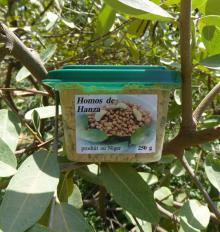Hanza (Boscia senegalensis, Capparaceae) During the second half of the 20th century, this plant was transformed into a symbol of drought and hunger. Particularly resilient, the seeds of Boscia senegalensis, or hanza, were almost the only source of calorific food available to hundreds of thousands of Sahelians during the famines of 1972 and 1984. Although this highlights its importance in food security, many people did not eat its seeds out of will but out of compulsion, and this has become entrenched in popular memory. To make matters worse, the seeds require four to five days of debittering with frequent water changes to release a very high concentration of glucocapparin, a type of mustard oil or mustard oil.1 During famines, people without mastery of the preparation technique rushed on the food, and with the droughts, it is likely that others had insufficient water for the proper transformation. As a result, some have eaten badly debittered hanza, which is neither palatable nor healthy. But when processed properly, the hanza seed becomes a staple food at its full value like beans or cereals. It contains about 20% protein after debittering,2 60-70% carbohydrates,3 and useful doses of zinc and iron.
4 It is a resistance food, recognized by the rural population to give good energy for prolonged physical work such as plowing the fields and during the cold season.9 It is also said to be compatible with consumers suffering from diabetes. Note that the water used for debittering cannot be reused for watering in the swamp5. The hanza plant grows between rainfalls of 100 and 600mm, across all the longitudes of the Sahelian strip. It tends to form areas of concentration where its presence becomes very abundant. It tolerates very hard soils but does not like sand dunes. Its flowering begins in October and November, and the fruits grow very slowly to ripen only in July. The fruits offer a sweet juice that surrounds the seed, and which can be made into jam. Hanza plants produce an average of 2 to 3 kg of dried seeds per year,5 6 or a production of 800 kg per hectare. This is about double the average for cereals in Niger which is around 400 kg per ha. The de-stigmatization of this food is well underway in Niger, and a social enterprise has started a modernized exploitation of the food, producing cookies, preserves, popcorn, flour and other hanza products. Various reports in the local media have covered this innovation.7 Several communities today express their wish to make better use of the hanza of their regions, and to bring this tree back to where it disappeared.
1Garvi J., Garvi-Bode R.D. 2014. Removing glucosinulates to create food security in the Sahel. Poster presented at ‘Glucosinolates and beyond.’ Third Internat. Glucosinolate Conf.. Wageningen UR, Netherlands, 12-15 Oct.2014
2Taehee R. Kim; Andrzej Pastuszyn; Dorothy J. Vanderjagt; Robert S. Glew; Mark Millson; Robert H. Glew 1997. The nutritional composition of seeds from Boscia senegalensis (Dilo) from the Republic of Niger. Journal of Food Composition and Analysis 10:73-81.
3Salih, Omar M., Nour, Abdelazim, M. & Harper, David B. 1991. Chemical and nutritional composition of two famine food sources used in Sudan, Mukheit (Boscia senegalensis) and Maikah (Dobera roxburghi). Journal of the Sciences of Food and Agriculture 57:367-377.
4Taehee R. Kim; Andrzej Pastuszyn; Dorothy J. Vanderjagt; Robert S. Glew; Mark Millson; Robert H. Glew 1997. The nutritional composition of seeds from Boscia senegalensis (Dilo) from the Republic of Niger. Journal of Food Composition and Analysis 10:73-81
5Maman Mato, H. 2014. Evaluation de la capacité de la productivité du « hanza » dans la région de Zinder. Rapport interne, Sahara Sahel Foods, Zinder, Niger.
6Van Dam, P. 2014. Analysis of the adoption process of hanza (Boscia senegalensis) in the region of Zinder, Niger Republic. BSc thesis, Soil Phsic and Landmanagement Group, Wageninge University, The Netherlands. 33 pp.
7Sahara Sahel Foods: www.saharasahel.org and www.saharasahelfoods.com . Retrieved November 2014. 8 Salih, Omar M., Nour, Abdelazim, M. & Harper, David B. 1991. Chemical and nutritional composition of two famine food sources used in Sudan, Mukheit (Boscia senegalensis) and Maikah (Dobera roxburghi). Journal of the Sciences of Food and Agriculture 57:367-377.


